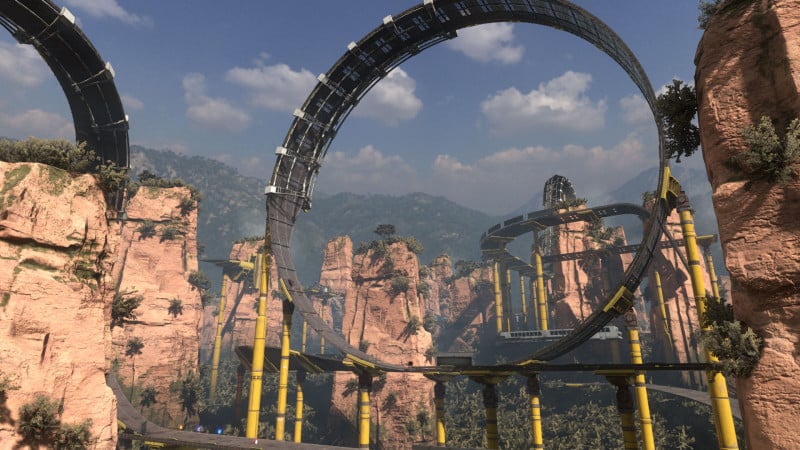Living apart from the world of simulation or arcade racers, the futuristic anti-grav racing genre has a devoted following among many enthusiasts. I count myself among those fans, having spent an embarrassing number of hours navigating tracks in various F-Zero and WipeOut courses, trying to improve my times. As such, Fast Fusion caught my attention right away as an early Switch 2 technical showpiece. Compared to many modern racers, it’s a relatively straightforward release, primarily focused on delivering a curated selection of high-speed tracks alongside a clever vehicle customization system that adds some creative flair. Fast Fusion doesn’t have a ton of bells and whistles. However, it does deliver intense speed, clever tactical twists, and breathtaking visuals that make it well worth the modest price of admission.
Like the games from which it draws inspiration, and the developer’s earlier anti-grav games, Fast Fusion is singularly focused on constant and nearly uncontrollable speed. Between boost pads and a triggerable boost meter, the intention is that you should be at top speed for virtually every second of the race, desperately careening around curves and hoping to avoid a crash. Course designs are top-notch and further contribute to the sense of hypersonic movement, particularly through long, straightaways and distant lines of sight.
While the core formula is relatively standard for the genre, several features add tactical and control complexity. A button press toggles the color of your car’s glow from blue to red, and you only get a speed boost from pads that match your current color. A jump button adds a high-risk tool to snag boost pick-ups high above the track. Higher speed vehicles will generally bump away and overtake slower vehicles, so there’s an additional challenge around knocking out the competition.
Impressive visuals accentuate the thrill of high-speed action. Nearly every course features a unique graphical aesthetic, ranging from a race through outer space to a track filled with perilous blasts of volcanic lava. Fast Fusion is an excellent showcase for the Switch 2’s capabilities, and I was blown away by some of the detail in 4K at 60fps. The game also features a high-energy soundtrack that is notable for its intensity, sitting somewhere between an ‘80s animated action movie and a deadmau5 concert. The speed, vibrant visuals, and hypnotic beats combine to create a heart-pumping cocktail.
A basic currency system rewards players with money from race completions and wins, which in turn unlocks more tracks and vehicles, each with slight but impactful differences in speed, acceleration, and boost. The fun part is that any two vehicles can be combined to create an improved model that incorporates the visual and performance features of both. I relished the resulting amalgamations and the chance to try out the new machines on the track to find a favorite.
The gradual track unlock process doesn’t add much to the affair, and I never warmed to either the solo time attack mode or the elimination-focused Super Hero mode. Recent updates since launch have added a few new tracks and a flexible photo mode. Additional “leagues” present the same tracks but with minor variations, but it was annoying to have to spend currency to unlock higher difficulties. The available 4-player splitscreen multiplayer similarly doesn’t add much in the way of additional twists, but it certainly further harkens back to older titles in this vein. But any way you cut it, even with those additions, the game is undoubtedly a tight but relatively short-lived experience.
Even so, I suspect many players may feel as I did; even after completing the available courses, it’s great fun to go back and perfect your pathfinding on each. The computer opponents in single-player mode can be difficult to beat, and higher difficulty leagues require some time to master. Perhaps most importantly, Fast Fusion injects adrenaline into a subgenre of racing that larger open-world and simulation projects have largely overlooked. This futuristic vibe and unrealistic speeds may not be for everyone, but I’m delighted to see this style of play still alive and kicking its way down the course.

